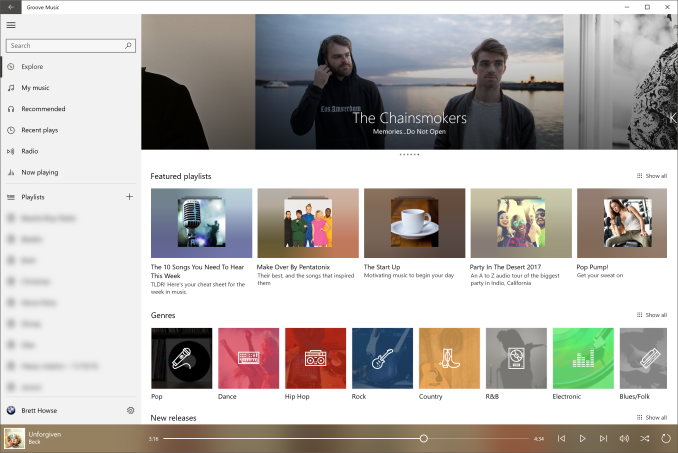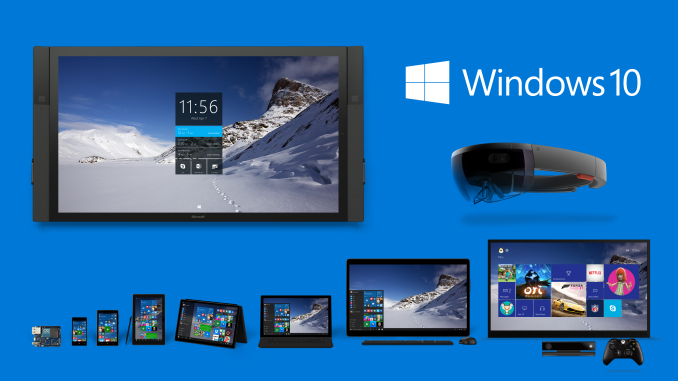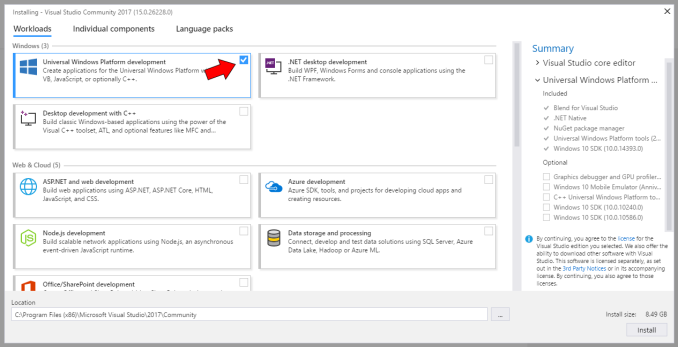The Windows 10 Creators Update Arrives
by Brett Howse on April 25, 2017 8:00 AM EST- Posted in
- Software
- Operating Systems
- Windows
- Microsoft
- Windows 10
Universal Windows Platform, now down a leg
For years, Microsoft was very clear about it’s ambitions to bring its platforms together, to give one single userbase to developers, rather than have to make apps for desktop, mobile, Xbox, Surface Hub, and eventually augmented reality. The efforts got serious in the Windows Phone 8 days, but it would still take several years for “Metro” apps to be morphed into the Universal Windows Platform (UWP). Microsoft promised a single platform for all of their apps, and they delivered. But it’s impossible to ignore their mobile play, which was floundering by the time they released Windows 10 Mobile.
Microsoft has all but abandoned their mobile efforts, instead embracing the dominant mobile ecosystems in Android and iOS, by bringing their apps to those environments. Sure, they still update Windows 10 Mobile, but with the Creators Update, only a handful of Windows 10 Mobile devices will be offered the update. It’s not a surprise, since Microsoft never really got any meaningful penetration in phones, but it certainly leaves UWP in an odd place. For years, Microsoft has been pushing UWP as a method to broaden application availability over multiple devices, but by abandoning their mobile strategy, it leaves them in a tough spot. UWP has suffered, perhaps partly because of this, but it certainly hasn’t gained the traction that Microsoft had hoped for. If it had, perhaps Windows 10 Mobile would not have been dead on arrival.
Without phone, UWP is now a tool to deploy apps across desktop, Xbox, Surface Hub, and mixed reality devices. But without a phone platform, that means that it’s basically just desktop. Even at just 5% phone usage share, phone would have been somewhere around 75-100 million devices. Xbox may eventually get there, but it’s going to be years, if ever. Surface Hub is a device that’s going to sell in the thousands, and Hololens is currently a developer-only item right now. That leaves the desktop, which is going to be the majority of the last official Windows 10 install base, pegged at 400 million devices at the end of September 2016. Expect a new figure to come soon, but regardless, almost all Windows 10 installs are on the PC.
That’s not necessarily a bad thing, although there are questions of where computing will go in the future, but for now, the PC is still the go-to device for most people when they need to get something done. But if one of your key points to pushing a new developer platform is cross-platform capabilities, but you only really have one platform that matters, it’s not ideal. Microsoft generally discusses upcoming developer news at their Build conference, which will be happening in May this year, so perhaps we will see some news there on where UWP goes from here.
The odd part about UWP and the cross-platform push that Microsoft has been doing for years, is that UWP could have been focused more on the desktop years ago, and improved to the point where it makes sense to use it on the desktop over older frameworks. But that push has never happened, despite some improvements to UWP.
Desktop has been held back by old app frameworks for years. Devices continue to improve, and older applications struggle to take advantage of High DPI displays, wide color gamuts, and more. UWP could have been the solution to this, but it was never sold as the solution to anything on the desktop. In fact, its limitations on the desktop are clear. Windows 10 brought the ability to run UWPs in a window on the desktop, but UWP is still treated as a mobile-first app platform, with all of the restrictions of a mobile device which is hampered by performance and power.
 Groove Music - a UWP Music app
Groove Music - a UWP Music app
Ideas that were spawned in the days of the push to mobile need to be abandoned, or at least add in options for developers to unlock more capabilities on the desktop. With 32 GB of memory in my desktop, I don’t really need apps frozen in the background when they aren’t the active window. With a desktop plugged into power, there is no reason a UWP can’t keep running all the time. Until desktop (and this includes laptops) becomes the focus of UWPs, the limited capabilities will restrict the apps that are brought to this framework, which means any benefits they would bring, such as touch support, share contract support, and high DPI capabilities, are going to be ignored for the more capable older frameworks.
Microsoft has done a lot of work to bring older applications to their store model, and that has been somewhat successful, especially with the Centennial bridge which allows Win32 apps to be converted to store packages, but at the end of the day, UWP needs to be a focus if they want it to succeed.












69 Comments
View All Comments
MattMe - Tuesday, April 25, 2017 - link
Are you by any chance running an install of 10 that was upgraded from an earlier version? Several test machines at work, and alll my home machines struggled after an upgrade, I hated it the first few weeks. The I did a fresh install on them and it fixed 99% of all issues I had on every device. Just a thought :)fm13 - Tuesday, April 25, 2017 - link
I tried upgrading from 8.1 Pro but gave up and just installed Win 10 on a formatted drive. So this is a "clean" install I'm talking about.Instyle - Wednesday, April 26, 2017 - link
An issue I've ran into is that the update files that got downloaded were in some corrupted state. So instead of checking for updates, Windows Update would try to use them and fail. The solution I've found is to delete C:\Windows\SoftwareDistribution. This is where update files get downloaded to (including new updates like the Creators Update, culmulative updates and security updates) before being applied. Normally you can't just rename/delete it as there is typically some update process running in it. You have to kill any process running in it by opening Task Manager > Performance > Open Resource Monitor > CPU > Associated Handles and enter the folder path into the Search box. It'll pull up a list of processes open in that folder, end each of them. Next go to the folder and either rename (if you're wary) or delete it. Then check for updates. Hope this helps!lord_anselhelm - Tuesday, April 25, 2017 - link
Don't know if this will help, but you might want to try the Windows Update Troubleshooter. I had a problem on my laptop where a couple of files had been corrupted and I was unable to update Windows. The troubleshooter fixed it. Also, consider using Windows Update MiniTool: it's so much nicer than the default updater.faizoff - Tuesday, April 25, 2017 - link
This update was surprisingly the smoothest update process for me. Too much stuff configured currently for me to do a clean install, the update itself went about without any consequence. No programs have been affected that I could see. The upgrade process has been getting better and better. Though there is still some issue with my wifi adapter when using the latest drivers provided by the mfg. wifi only works well with a particular version of the driver.I like the Edge enhancements, don't use game mode so don't care about it. paint 3D is fun and I'd never thought I'd actually prefer the previous iteration of the start menu with all apps tagged along with the pinned tiles. Really warming up to it now.
One issue still prevails that's been there from the start, explorer.exe crashes randomly and restarts, still cannot for the life of me figure that one out.
blahsaysblah - Tuesday, April 25, 2017 - link
The security center needs an update. I guess maybe in minority but my PC is on a UPS and i have its status connected via USB port. So i have two yellow warnings about LCD being set to max brightness and sleep being turned off, both impacting battery life.The problem is there is no way to turn off/confirm those alerts, so i always see a yellow triangle. So i just ignore it now as i have no way to know if there is a new and valid issue.
DanNeely - Tuesday, April 25, 2017 - link
The workaround for the LCD brightness notice is apparently to set the screen at 99%. (Seen elsewhere, not tested.)benedict - Tuesday, April 25, 2017 - link
The Creators Update broke the DateTime Picker on all legacy applications. Microsoft are aware of this problem since early March and still haven't done anything to fix this. I've told all my customers who were unfortunate enough to update to revert back to the old version and wait for Microsoft to fix their bugs.JimmiG - Tuesday, April 25, 2017 - link
Is game mode really activated by default? I've always had to open the game bar and check the "User game mode with this game" checkbox.mr_tawan - Tuesday, April 25, 2017 - link
I think it's enabled by default only in select title and UWP games.